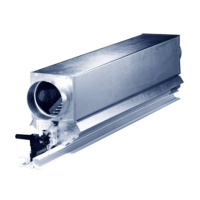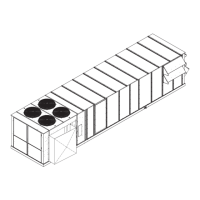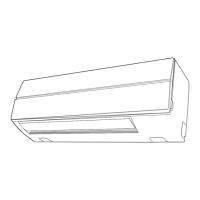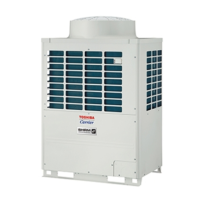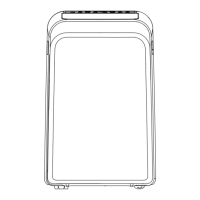Do you have a question about the Carrier MODU-PAC 50DF and is the answer not in the manual?
Precise system control with solid-state logic panel for maximum operating economy.
Curb design eliminates steel support frames, saves time, and reduces installation costs.
Large duct openings for low airflow velocities and even air distribution.
Quick-release panels, slide-out filters, and plug-in relays simplify inspection and maintenance.
Intertwined coils for optimum heat transfer and efficient compressor operation.
Features like Time Guard circuit, single-location power, fixed-speed fan, and low-ambient operation.
Uses cool outside air for savings, reduces compressor wear, and lowers operating costs.
Provides substantial energy cost savings by operating fans at low speed.
Exhausts up to 75% of return air, designed for bottom duct connections.
Available in multiple capacities, factory wired for 2-stage heat.
Extended surface media provides high filtration efficiency.
Provides increased performance for requirements beyond standard operation.
Provides energy savings via setback/setup, 7-day clock, and morning warmup thermostat.
Automatically exhausts excess air during economizer operation.
Provides a strong, watertight interface between unit and roof.
Provides capacity control for reduced compressor capacity at light loads.
Maintains correct condensing temperature at low outdoor air temperatures.
Offers choices like integral sensor, remote sensor, or subbase mounting.
Identify space requirements and design conditions for unit selection.
Choose a unit based on required cooling capacity and conditions.
Select a unit that meets the design heating condition requirement.
Identify fan speed and power requirements at design conditions.
Choose a unit that matches the available power supply characteristics.
Details on compressor, fan motor, and heater protection devices.
Introduction to system controls and operating sequences.
Covers economizer operation, two-speed fan, and various operating modes.
Details on concentric and thru-the-side duct connections.
Information on operating at low outdoor air temperatures.
Factors affecting sound and vibration in rooftop unit installations.
General specifications for the unit construction and mounting.
Detailed descriptions of available options and accessories.
Highlights ease of design and low installation costs for packaged systems.
Details how roof curb and integrated connections minimize jobsite expenses.
Dampers rated at 3% with 3-in. wg pressure differential limit infiltration.
Automatically closes outdoor air dampers during power failure.
Senses outside air heat content for optimum cooling use.
Saves fuel by keeping outdoor air damper closed until warmup is complete.
Provides temporary unit operation during unoccupied periods.
Provides cooling of full air stream with minimum compression.
Details options like static pressure control, roof curb, Motormaster, filters, motors, heaters.
Define space requirements and design conditions for unit selection.
Calculate the total heat load for the space.
Calculate the maximum supply air quantity needed.
Determine the required outdoor air ventilation rate.
Calculate mixed air temperatures entering the evaporator.
Select a trial unit based on calculated loads and conditions.
Choose the appropriate indoor fan speed and motor bhp.
Select a unit based on job electrical characteristics.
Describes sequences for economizer and 2-speed fan operation.
Details on compressor, fan motor, and heater protection devices.
General specifications for unit construction, materials, and mounting.
Details on compressors, service valves, and coil design.
Describes microprocessor, thermostat, and remote control panel functions.
Outlet sized for small power loads or service lights.
Economizer features like low-leak dampers and integrated cooling.
Tracks provided for accommodating field-installed hydronic coils.
Specifications for indoor and outdoor fan types and motors.
Protection features including fusible plug, pressurestats, and timing devices.
Describes power wiring and utility connection routing.
Specifies unit casing width, length, and height.
Provides options for increased fan performance beyond standard capacity.
Filter options for 50% and up to 95% efficiency.
Unit support, watertight enclosure, and NRCA compliance.
Self-locating damper assembly to maintain duct static pressure.
Provides indoor air fan speed control for unit operation down to -20F.
Precise system control with solid-state logic panel for maximum operating economy.
Curb design eliminates steel support frames, saves time, and reduces installation costs.
Large duct openings for low airflow velocities and even air distribution.
Quick-release panels, slide-out filters, and plug-in relays simplify inspection and maintenance.
Intertwined coils for optimum heat transfer and efficient compressor operation.
Features like Time Guard circuit, single-location power, fixed-speed fan, and low-ambient operation.
Uses cool outside air for savings, reduces compressor wear, and lowers operating costs.
Provides substantial energy cost savings by operating fans at low speed.
Exhausts up to 75% of return air, designed for bottom duct connections.
Available in multiple capacities, factory wired for 2-stage heat.
Extended surface media provides high filtration efficiency.
Provides increased performance for requirements beyond standard operation.
Provides energy savings via setback/setup, 7-day clock, and morning warmup thermostat.
Automatically exhausts excess air during economizer operation.
Provides a strong, watertight interface between unit and roof.
Provides capacity control for reduced compressor capacity at light loads.
Maintains correct condensing temperature at low outdoor air temperatures.
Offers choices like integral sensor, remote sensor, or subbase mounting.
Identify space requirements and design conditions for unit selection.
Choose a unit based on required cooling capacity and conditions.
Select a unit that meets the design heating condition requirement.
Identify fan speed and power requirements at design conditions.
Choose a unit that matches the available power supply characteristics.
Details on compressor, fan motor, and heater protection devices.
Introduction to system controls and operating sequences.
Covers economizer operation, two-speed fan, and various operating modes.
Details on concentric and thru-the-side duct connections.
Information on operating at low outdoor air temperatures.
Factors affecting sound and vibration in rooftop unit installations.
General specifications for the unit construction and mounting.
Detailed descriptions of available options and accessories.
Highlights ease of design and low installation costs for packaged systems.
Details how roof curb and integrated connections minimize jobsite expenses.
Dampers rated at 3% with 3-in. wg pressure differential limit infiltration.
Automatically closes outdoor air dampers during power failure.
Senses outside air heat content for optimum cooling use.
Saves fuel by keeping outdoor air damper closed until warmup is complete.
Provides temporary unit operation during unoccupied periods.
Provides cooling of full air stream with minimum compression.
Details options like static pressure control, roof curb, Motormaster, filters, motors, heaters.
Define space requirements and design conditions for unit selection.
Calculate the total heat load for the space.
Calculate the maximum supply air quantity needed.
Determine the required outdoor air ventilation rate.
Calculate mixed air temperatures entering the evaporator.
Select a trial unit based on calculated loads and conditions.
Choose the appropriate indoor fan speed and motor bhp.
Select a unit based on job electrical characteristics.
Describes sequences for economizer and 2-speed fan operation.
Details on compressor, fan motor, and heater protection devices.
General specifications for unit construction, materials, and mounting.
Details on compressors, service valves, and coil design.
Describes microprocessor, thermostat, and remote control panel functions.
Outlet sized for small power loads or service lights.
Economizer features like low-leak dampers and integrated cooling.
Tracks provided for accommodating field-installed hydronic coils.
Specifications for indoor and outdoor fan types and motors.
Protection features including fusible plug, pressurestats, and timing devices.
Describes power wiring and utility connection routing.
Specifies unit casing width, length, and height.
Provides options for increased fan performance beyond standard capacity.
Filter options for 50% and up to 95% efficiency.
Unit support, watertight enclosure, and NRCA compliance.
Self-locating damper assembly to maintain duct static pressure.
Provides indoor air fan speed control for unit operation down to -20F.
| Model Number | 50DF |
|---|---|
| Category | Air Conditioner |
| Cooling Capacity | 50, 000 BTU/h |
| Refrigerant Type | R-410A |
| Voltage | 208/230V |
| Phase | 1 |
